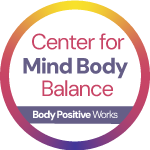Eating Disorder Treatment New Jersey
Licensed Holistic Eating Disorder Treatment in Bergen County
Eating Disorder Treatment Near Me
Are you looking for confidential support and treatment for treat eating disorder in New Jersey? We are specialists in treating negative body image and eating disorders.
Body Positive Works offers integrated eating disorder help in the form of services, programs, and classes to support you on your journey back to yourself.
Call 201-708-8448 or request a confidential eating disorder treatment callback to find out more.
Identifying Eating Disorders
An eating disorder is an addiction, encompassing a challenged relationship with food, body, and self.
Tween girls, adolescent girls, and young women are the most likely to be associated with an eating disorder. However, an eating disorder can affect anyone, regardless of age, stage of life, sexual orientation, gender identity, class, or religion. Family members are deeply impacted as well.
Some signs and symptoms of eating disorders include spending time worrying about weight and shape, eating very little, eating more than feels physically comfortable, over-exercising, and purging or taking laxatives after food intake.
You are not alone, we are here to support you.
There are several types of eating disorders:
Anorexia Nervosa
This is the most well-known but actually the least common eating disorder. Food intake is severely restricted, and symptoms include being very underweight and having a distorted body image.
Bulimia Nervosa
This is binge-eating followed by purging. Bulimia sufferers tend to have a relatively normal weight rather than becoming underweight.
Binge Eating Disorder
This is when a person is unable to control their food intake – eating large quantities of food all at once and then feeling shame or guilt. There is no purging. People with Binge Eating Disorder are often overweight.
Other Specified Feeding or Eating Disorder
This is when your symptoms don’t match any of the above, but it doesn’t mean it’s less serious.
Why Choose Us for Eating Disorder Treatment in New Jersey?
Seeking Compassionate Eating Disorder Treatment in New Jersey? You’ve Come to the Right Place!
At Body Positive Works, we understand the challenges and complexities surrounding negative body image and eating disorders. Our wellness center offers a safe and confidential space for individuals in New Jersey to seek professional support and treatment for eating disorders. Our team of specialists is dedicated to providing comprehensive care and integrated eating disorder help to support you on your journey to healing and self-discovery.
Comprehensive Eating Disorder Services
🍃 Specialized Treatment: Our experienced therapists are specialists in treating negative body image and eating disorders. We provide evidence-based therapies tailored to address the unique needs of each individual, fostering a compassionate and empowering healing journey.
Reclaim Your Life
At Body Positive Works, we firmly believe in the power of resilience and self-acceptance. Our integrated approach to eating disorder treatment aims to provide you with the necessary tools and support to reclaim your life and rediscover your innate worth.
Take the First Step Towards Healing
Reaching out for support is a courageous step towards reclaiming your life from the grip of eating disorders. We invite you to call 201-708-8448 or request a confidential eating disorder treatment callback to explore how our specialized services can empower you on your path to freedom and self-love.
You deserve a life that is abundant, joyful, and free from the constraints of negative body image and eating disorders. Let us walk alongside you as you embark on a journey of healing and self-discovery. 🌸🌟💚
We believe that there is no separation between mind and body. As such, we take an integrative and holistic approach to treatment and recovery for individuals, and their families, struggling with eating disorders and disordered eating.
Having access to multiple modalities, all under one roof, Body Positive Works affords individuals an opportunity to seek recovery for their whole self – body, mind, and spirit. We have created a space where individuals can speak authentically and openly about their relationship with food, body, self, and society, supporting individuals, and their families, struggling with eating disorders and disordered eating.
Speak to one of our receptionists if you would like to discuss how to treat eating disorders.
Call 201-708-8448.
How to Find Eating Disorder Treatment in New Jersey

Discover Compassionate Eating Disorder Treatment in New Jersey at Our Serene Heritage House
Nestled in the heart of Saddle River, Bergen County, NJ, our beautiful heritage house at Body Positive Works serves as a haven for those seeking eating disorder treatment. With a commitment to providing compassionate support and specialized care, we are dedicated to helping individuals on their journey towards healing and recovery.
🏡 A Tranquil Sanctuary: Our wellness center exudes a calming atmosphere, offering a safe space for you to explore your emotions and experiences surrounding eating disorders. Step into our serene heritage house and embark on a transformative healing journey.
📍 Conveniently Located: Strategically positioned across the street from Wandell Elementary School and next door to the Municipal Building, accessing our facility is effortless. Additionally, we are centrally located with convenient access to Rt. 17 and the Garden State Parkway, making it easy for residents from various localities, including Fair Lawn, Glen Rock, Hawthorne, Hillsdale, Hohokus, Mahwah, and Waldwick, to reach us.
🗺️ Explore the Map: Curious about the distance from your location? Check out our map to see just how close we are to you. With our accessible location, we aim to make your journey to healing as seamless as possible.
At Body Positive Works, we believe that your healing journey deserves a nurturing and supportive environment. Let our heritage house be the starting point for your transformation towards a life free from the grasp of eating disorders. Take that courageous step towards reclaiming your well-being today.

